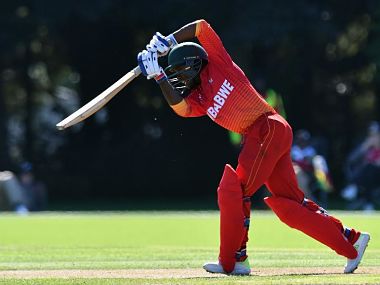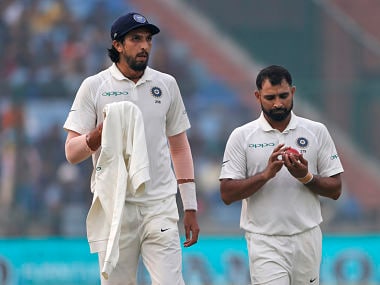India vs South Africa: Ishant Sharma finally becoming the anchor bowler he was always meant to be
Plugging runs and etching out the odd wicket has become a hallmark of Ishant’s bowling off late. On a tough wicket at Centurion, his performance was a microcosm of this trait in what can be described as the latest phase in the Delhi pacer’s career.
Chetan Narula, Jan,22 2018
- ICC Under-19 World Cup, 2018 ZIM Vs NAM Zimbabwe Under-19 beat Namibia Under-19 by 7 wickets
- ICC Under-19 World Cup, 2018 NZ Vs SA New Zealand Under-19 beat South Africa Under-19 by 71 runs
- ICC Under-19 World Cup, 2018 ENG Vs CAN England Under-19 beat Canada Under-19 by 282 runs
- ICC Under-19 World Cup, 2018 WI Vs KEN West Indies Under-19 beat Kenya Under-19 by 222 runs
| Rank | Team | Points | Rating |
|---|---|---|---|
| 1 | India | 4969 | 124 |
| 2 | South Africa | 3888 | 111 |
| 3 | Australia | 4174 | 104 |
| 4 | New Zealand | 3489 | 100 |
| 5 | England | 4829 | 99 |
| 6 | Sri Lanka | 4058 | 94 |
| Rank | Team | Points | Rating |
|---|---|---|---|
| 1 | South Africa | 6386 | 120 |
| 2 | India | 6680 | 119 |
| 3 | New Zealand | 6650 | 117 |
| 4 | England | 6483 | 116 |
| 5 | Australia | 6077 | 113 |
| 6 | Pakistan | 4875 | 96 |
| Rank | Team | Points | Rating |
|---|---|---|---|
| 1 | New Zealand | 2262 | 126 |
| 2 | Pakistan | 2843 | 124 |
| 3 | India | 3385 | 121 |
| 4 | England | 2029 | 119 |
| 5 | West Indies | 2538 | 115 |
| 6 | South Africa | 2238 | 112 |





When India’s playing XI for the Cape Town Test was announced, there were a few surprises therein. Rohit Sharma instead of Ajinkya Rahane made the headlines for obvious reasons, as did Virat Kohli’s explanation of the move on the basis of form. The inclusion of Jasprit Bumrah was another, with the exclusion of Ishant Sharma the final one.
In a way, the last two were somewhat connected — India needed a third pacer after Mohammed Shami and Bhuvneshwar Kumar, and they went in with Bumrah, handing him a maiden Test cap. It made for some wonder — Ishant, with 79 Tests in his kitty (at that stage), had been sidelined for a debutant?
Ten days later, on the second day at Centurion, Ishant made a clarification in the post-play press conference. “Actually I was supposed to play the first Test, but I fell ill when I reached South Africa and couldn’t recover in time,” he said.
India's Ishant Sharma reacts on the first day of the second Test at Centurion Park. AP
Ahead of the first Test, only Ravindra Jadeja’s illness — and subsequent unavailability — was announced. It would have helped to know about Ishant as well, especially considering that there is a major ongoing debate about India’s selection decisions on this tour. This though isn’t about that. Instead, it is about how Ishant was missed at Newlands, and how his subsequent presence at Centurion helped the Indian team keep South Africa in check.
Sample this.
Scenario A: It was the first innings at Newlands, and South Africa were reduced to 12/3. Shami had a poor start to the game, and he needed vital support from the other end. Bumrah was introduced into the attack and AB de Villiers exploited his lack of experience to score a swift half-century and took the game away from India.
Scenario B: In the first innings at SuperSport Park, South Africa won the toss and took first strike on a batting beauty. Shami was off-colour in his first spell again, and was taken for runs. India had to make the first change in the 8th over. However, that move worked as Ishant, coming on, was able to cut off the flow of runs.
“The game was opening up a bit because of runs in the first session. So my effort was to keep bowling in good areas, and bowl in the batsman’s weak areas, set your fields and bowl according to plans. Don’t give away too many runs and that is what I was thinking,” he had said.
Ishant is a man of few words, and when he does talk in the press conference, the words ‘good areas’, ‘strengths’ and ‘weaknesses’ are often repeated. Once, in Nottingham, after the day’s play, he had used ‘good areas’ six times in six sentences. It is enough to confuse those listening, but watch intently the next time he bowls and the meaning is clear. Ishant, with all his experience, looks to ascertain the right length of any pitch and bowls to hit the off-stump using his natural movement. He wants to bowl to a plan, being the senior bowler in the side.
“He is someone who doesn’t run through sides. He will hit consistent lengths and plug gaps in the bowling attack all day. Suddenly he will grab 2-3 wickets for you in one particular innings and you are left wondering where did that spell come from,” Kohli had said during the tour of West Indies in 2016, after another gritty spell wherein Ishant held one end together during the third Test in St Lucia.
Of course, the immediate argument against this is that the natural movement away from batsmen causes more problems. Instead of off-stump, if the pacers look to target the first slip, then that away-going delivery will make a deeper wicket-taking impact and such bowlers have a tendency to run through the batting line-up. You expect Shami or Kumar, even Umesh Yadav, to do so for they take the ball away, yet also possess the ability to bring it back in.
Like in batting though, you need someone to drop anchor when it comes to bowling as well. Someone who can bowl that off-stump line because on flatter wickets, the margin of error increases with the away-going delivery. A case in point was the second session on day four of the Centurion Test, when everyone was surprised as to why Shami wasn’t bowling after a fiery morning spell.
Instead, it was Ishant again, bowling to the grinding partnership between Faf du Plessis and Vernon Philander. While the duo were happy playing for time, India’s senior-most bowler made good use of the soft ball to cut down the flow of runs. Overall, India’s tactics were questionable. They should have attacked more, but the onus for once was on containing runs, for the batsmen were bound to make a mistake. Ishant, using all his experience, removed both Philander and Keshav Maharaj in that spell to open the gateways for India.
This — plugging runs and etching out the odd wicket — has become a hallmark of Ishant’s bowling off late. On a tough wicket at Centurion, his performance was a microcosm of this trait in what can be described as the latest phase in the Delhi pacer’s career.
And it reflects in the wickets’ column — 44 scalps in 19 Tests at an average of 31.15 and economy rate of 2.78. It is lower than his career-average of 36.13 and career-economy of 3.24. It has served him — and the team well — since 2015, when India toured Sri Lanka. He doesn’t lead the attack per say, not anymore in terms of opening the bowling, but coming in as first change, he performs that anchor role.
“Often the outside criticism is unwarranted. Team management doesn’t look at all bowlers in the same mould, some are more attacking than others, and then there are those who can do a specific job as per their particular strengths. Over the years, Ishant has grown into that latter category,” said former Indian bowling coach Eric Simons.
His words almost seal what is now a changed course for Ishant. He is often accused of not looking the part of a fast bowler who has already played 80 Tests. Yet, it is conveniently forgotten that he played a majority of those games a little too early in his career.
Maybe now, just maybe, in his newfound holding role over the past three seasons, Ishant is finally becoming the bowler that he was always meant to be.
Published Date:Jan 22, 2018
| Updated Date: Jan 22, 2018
Also See
India vs South Africa: Bold selection decisions like dropping Ajinkya Rahane and KL Rahul backfired for visitors
India vs South Africa: Team management rejected BCCI's idea to send Test regulars early to acclimatise, claims report
India vs South Africa: Visitors' top order batsmen need to keep their rash impulses in check